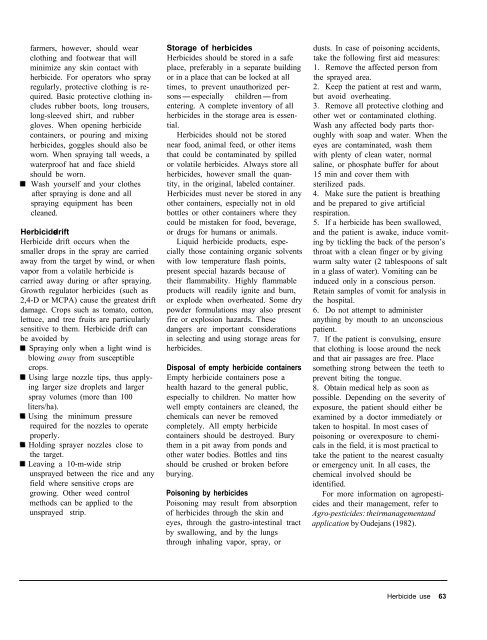A handbbok on Weed Control in Rice.pdf
A handbbok on Weed Control in Rice.pdf
A handbbok on Weed Control in Rice.pdf
Create successful ePaper yourself
Turn your PDF publications into a flip-book with our unique Google optimized e-Paper software.
farmers, however, should wear<br />
cloth<strong>in</strong>g and footwear that will<br />
m<strong>in</strong>imize any sk<strong>in</strong> c<strong>on</strong>tact with<br />
herbicide. For operators who spray<br />
regularly, protective cloth<strong>in</strong>g is re-<br />
quired. Basic protective cloth<strong>in</strong>g <strong>in</strong>-<br />
cludes rubber boots, l<strong>on</strong>g trousers,<br />
l<strong>on</strong>g-sleeved shirt, and rubber<br />
gloves. When open<strong>in</strong>g herbicide<br />
c<strong>on</strong>ta<strong>in</strong>ers, or pour<strong>in</strong>g and mix<strong>in</strong>g<br />
herbicides, goggles should also be<br />
worn. When spray<strong>in</strong>g tall weeds, a<br />
waterproof hat and face shield<br />
should be worn.<br />
Wash yourself and your clothes<br />
after spray<strong>in</strong>g is d<strong>on</strong>e and all<br />
spray<strong>in</strong>g equipment has been<br />
cleaned.<br />
Herbicide drift<br />
Herbicide drift occurs when the<br />
smaller drops <strong>in</strong> the spray are carried<br />
away from the target by w<strong>in</strong>d, or when<br />
vapor from a volatile herbicide is<br />
carried away dur<strong>in</strong>g or after spray<strong>in</strong>g.<br />
Growth regulator herbicides (such as<br />
2,4-D or MCPA) cause the greatest drift<br />
damage. Crops such as tomato, cott<strong>on</strong>,<br />
lettuce, and tree fruits are particularly<br />
sensitive to them. Herbicide drift can<br />
be avoided by<br />
Spray<strong>in</strong>g <strong>on</strong>ly when a light w<strong>in</strong>d is<br />
blow<strong>in</strong>g away from susceptible<br />
crops.<br />
Us<strong>in</strong>g large nozzle tips, thus apply<strong>in</strong>g<br />
larger size droplets and larger<br />
spray volumes (more than 100<br />
liters/ha).<br />
Us<strong>in</strong>g the m<strong>in</strong>imum pressure<br />
required for the nozzles to operate<br />
properly.<br />
Hold<strong>in</strong>g sprayer nozzles close to<br />
the target.<br />
Leav<strong>in</strong>g a 10-m-wide strip<br />
unsprayed between the rice and any<br />
field where sensitive crops are<br />
grow<strong>in</strong>g. Other weed c<strong>on</strong>trol<br />
methods can be applied to the<br />
unsprayed strip.<br />
Storage of herbicides<br />
Herbicides should be stored <strong>in</strong> a safe<br />
place, preferably <strong>in</strong> a separate build<strong>in</strong>g<br />
or <strong>in</strong> a place that can be locked at all<br />
times, to prevent unauthorized per-<br />
s<strong>on</strong>s-especially children-from<br />
enter<strong>in</strong>g. A complete <strong>in</strong>ventory of all<br />
herbicides <strong>in</strong> the storage area is essen-<br />
tial.<br />
Herbicides should not be stored<br />
near food, animal feed, or other items<br />
that could be c<strong>on</strong>tam<strong>in</strong>ated by spilled<br />
or volatile herbicides. Always store all<br />
herbicides, however small the quan-<br />
tity, <strong>in</strong> the orig<strong>in</strong>al, labeled c<strong>on</strong>ta<strong>in</strong>er.<br />
Herbicides must never be stored <strong>in</strong> any<br />
other c<strong>on</strong>ta<strong>in</strong>ers, especially not <strong>in</strong> old<br />
bottles or other c<strong>on</strong>ta<strong>in</strong>ers where they<br />
could be mistaken for food, beverage,<br />
or drugs for humans or animals.<br />
Liquid herbicide products, espe-<br />
cially those c<strong>on</strong>ta<strong>in</strong><strong>in</strong>g organic solvents<br />
with low temperature flash po<strong>in</strong>ts,<br />
present special hazards because of<br />
their flammability. Highly flammable<br />
products will readily ignite and burn,<br />
or explode when overheated. Some dry<br />
powder formulati<strong>on</strong>s may also present<br />
fire or explosi<strong>on</strong> hazards. These<br />
dangers are important c<strong>on</strong>siderati<strong>on</strong>s<br />
<strong>in</strong> select<strong>in</strong>g and us<strong>in</strong>g storage areas for<br />
herbicides.<br />
Disposal of empty herbicide c<strong>on</strong>ta<strong>in</strong>ers<br />
Empty herbicide c<strong>on</strong>ta<strong>in</strong>ers pose a<br />
health hazard to the general public,<br />
especially to children. No matter how<br />
well empty c<strong>on</strong>ta<strong>in</strong>ers are cleaned, the<br />
chemicals can never be removed<br />
completely. All empty herbicide<br />
c<strong>on</strong>ta<strong>in</strong>ers should be destroyed. Bury<br />
them <strong>in</strong> a pit away from p<strong>on</strong>ds and<br />
other water bodies. Bottles and t<strong>in</strong>s<br />
should be crushed or broken before<br />
bury<strong>in</strong>g.<br />
Pois<strong>on</strong><strong>in</strong>g by herbicides<br />
Pois<strong>on</strong><strong>in</strong>g may result from absorpti<strong>on</strong><br />
of herbicides through the sk<strong>in</strong> and<br />
eyes, through the gastro-<strong>in</strong>test<strong>in</strong>al tract<br />
by swallow<strong>in</strong>g, and by the lungs<br />
through <strong>in</strong>hal<strong>in</strong>g vapor, spray, or<br />
dusts. In case of pois<strong>on</strong><strong>in</strong>g accidents,<br />
take the follow<strong>in</strong>g first aid measures:<br />
1. Remove the affected pers<strong>on</strong> from<br />
the sprayed area.<br />
2. Keep the patient at rest and warm,<br />
but avoid overheat<strong>in</strong>g.<br />
3. Remove all protective cloth<strong>in</strong>g and<br />
other wet or c<strong>on</strong>tam<strong>in</strong>ated cloth<strong>in</strong>g.<br />
Wash any affected body parts thoroughly<br />
with soap and water. When the<br />
eyes are c<strong>on</strong>tam<strong>in</strong>ated, wash them<br />
with plenty of clean water, normal<br />
sal<strong>in</strong>e, or phosphate buffer for about<br />
15 m<strong>in</strong> and cover them with<br />
sterilized pads.<br />
4. Make sure the patient is breath<strong>in</strong>g<br />
and be prepared to give artificial<br />
respirati<strong>on</strong>.<br />
5. If a herbicide has been swallowed,<br />
and the patient is awake, <strong>in</strong>duce vomit<strong>in</strong>g<br />
by tickl<strong>in</strong>g the back of the pers<strong>on</strong>’s<br />
throat with a clean f<strong>in</strong>ger or by giv<strong>in</strong>g<br />
warm salty water (2 tablespo<strong>on</strong>s of salt<br />
<strong>in</strong> a glass of water). Vomit<strong>in</strong>g can be<br />
<strong>in</strong>duced <strong>on</strong>ly <strong>in</strong> a c<strong>on</strong>scious pers<strong>on</strong>.<br />
Reta<strong>in</strong> samples of vomit for analysis <strong>in</strong><br />
the hospital.<br />
6. Do not attempt to adm<strong>in</strong>ister<br />
anyth<strong>in</strong>g by mouth to an unc<strong>on</strong>scious<br />
patient.<br />
7. If the patient is c<strong>on</strong>vuls<strong>in</strong>g, ensure<br />
that cloth<strong>in</strong>g is loose around the neck<br />
and that air passages are free. Place<br />
someth<strong>in</strong>g str<strong>on</strong>g between the teeth to<br />
prevent bit<strong>in</strong>g the t<strong>on</strong>gue.<br />
8. Obta<strong>in</strong> medical help as so<strong>on</strong> as<br />
possible. Depend<strong>in</strong>g <strong>on</strong> the severity of<br />
exposure, the patient should either be<br />
exam<strong>in</strong>ed by a doctor immediately or<br />
taken to hospital. In most cases of<br />
pois<strong>on</strong><strong>in</strong>g or overexposure to chemicals<br />
<strong>in</strong> the field, it is most practical to<br />
take the patient to the nearest casualty<br />
or emergency unit. In all cases, the<br />
chemical <strong>in</strong>volved should be<br />
identified.<br />
For more <strong>in</strong>formati<strong>on</strong> <strong>on</strong> agropesti-<br />
cides and their management, refer to<br />
Agro-pesticides: their management and<br />
applicati<strong>on</strong> by Oudejans (1982).<br />
Herbicide use 63











